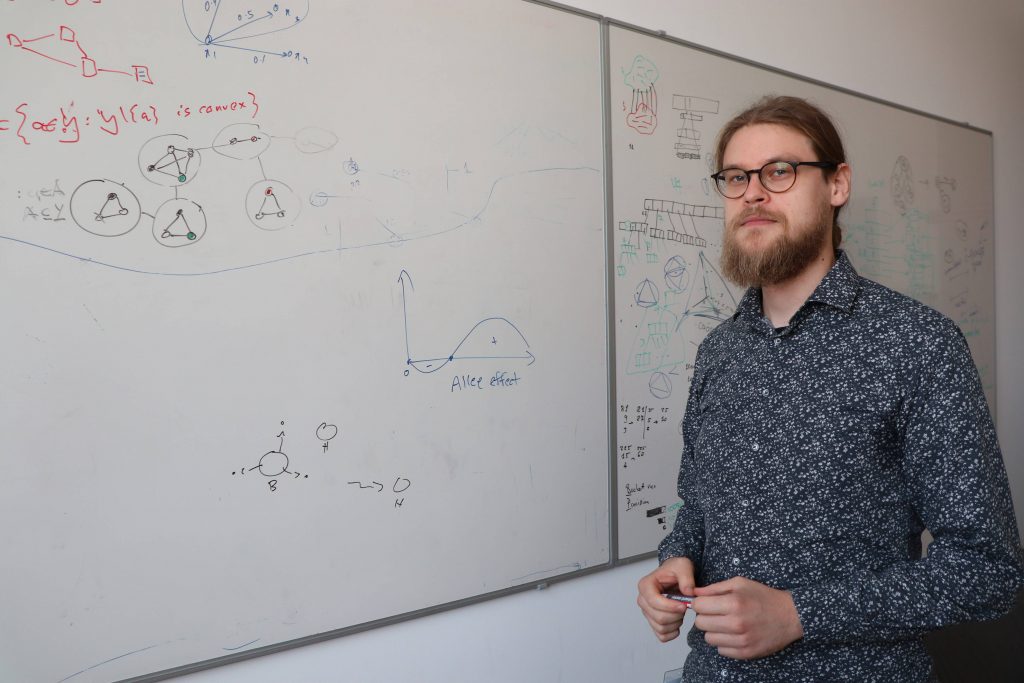October 1, 2018
With a little help from my friends
Mathematical model explains why some bacteria can make us sick even in small doses – Study published in PNAS

Just a few Shigella bacteria are enough to make anyone catch gastroenteritis, while to get sick from Cholera, thousands to millions of Vibrio cholerae bacteria have to be swallowed. Why does the dose needed to cause disease differ so much between bacteria? Based on observational data, biologists have previously proposed that this difference could be due to how bacteria attack their hosts: For example,while Shigella bacteria act locally by directly injecting proteins into host cells, Cholera bacteria attack from a distance by secreting cholera toxin. Joel Rybicki, postdoc at the Institute of Science and Technology Austria (IST Austria), and his colleagues Eva Kisdi and Jani Anttila at the University of Helsinki, built a mathematical model of bacterial infections. Their results support the hypothesis that the scale of pathogenetic mechanisms is the reason why different bacteria have different infective doses. They predict that the mechanism also influences how quickly an infection spreads in the host. Their study is published today in PNAS.
Rybicki and colleagues built a mathematical model that reflects bacterial infections. Compared with real-life bacteria, this “theoretical” bacterium allows the researchers to change just one aspect of the bacterium, in this case the mechanism of pathogenesis, while keeping all other aspects the same – a feat which would be difficult, if not impossible, to accomplish experimentally. In their model, the researchers can seamlessly dial up or down the distance at which the bacterium acts to attack the host and evade the immune system. All else being equal, they see that when the bacterium releases a toxin that acts locally, only few bacteria are needed to start an infection, while when the bacterium releases a toxin that acts over a long distance, a large number of bacteria are needed to get an infection going. Their model gives a theoretical basis for the phenomenon linking infective dose and the scale of the pathogenic mechanism.
The researchers’ models show that there is a threshold for infective doses, Rybicki explains: “Bacteria that attack a host using spreading toxins have a problem. When there is only one bacterium, the toxin it produces spreads away, leaving it defenseless, and the immune system can attack the bacterium. So the bacterium needs a little help from its friends: only when there are enough other bacteria around releasing toxins are they all protected from the immune system. For bacteria with locally acting toxin, the threshold is lower: the toxin doesn’t spread away so even a few bacteria acting together are protected from immune attack.”
Simulations of what happens during local and distant infections showed that when distantly acting bacteria have taken hold and started an infection, the infection spreads quickly. Locally acting bacteria start an infection at a lower threshold, but the infection spreads more slowly at higher doses. “This could be an explanation for why these different mechanisms of pathogenesis evolved in the first place”, Rybicki says.
Joel Rybicki joined IST Austria as an ISTplus postdoctoral fellow in the group of Dan Alistarh in January 2018. IST Austria set up the ISTplus postdoctoral program, which is partially funded by the European Union, to attract outstanding postdoctoral fellows. Joel Rybicki studied distributed computing, but in his previous postdoc, he also analyzed problems in mathematical biology: “This is the reason why I came to IST Austria. As people from different disciplines work together at one campus, I’m hoping that I can combine my interests and pursue questions both in mathematical biology and theoretical computer science.” Rybicki currently also studies ecological questions such as habitat fragmentation, which have surprising similarities with the study published now: “In this study, we are using ecological modeling techniques at a microbial level. It is interesting that we can use the same mathematical modeling approaches to study very different biological phenomena.”



